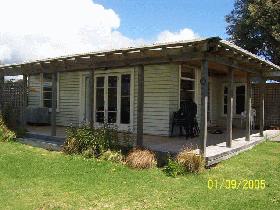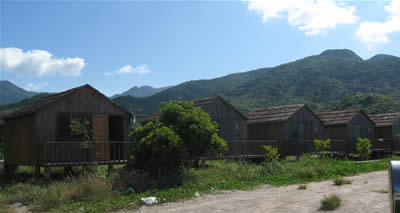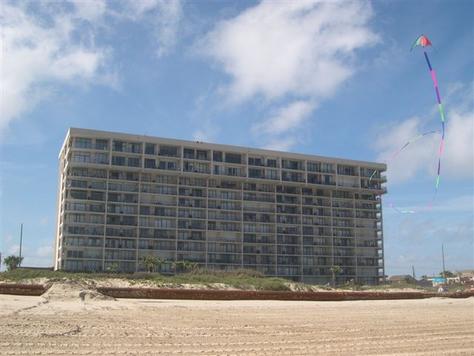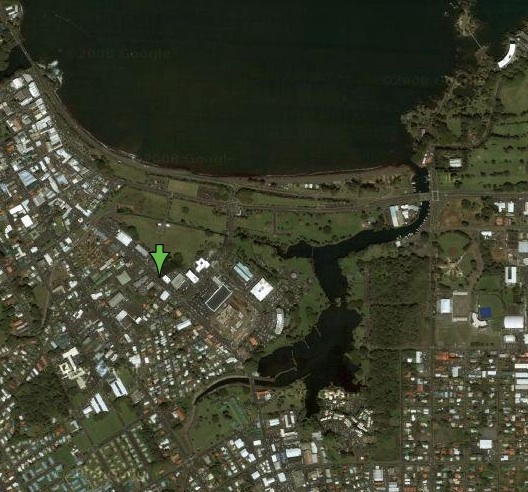
Coastal Erosion Policy Issues
People like to live close to the beach. Hundreds of thousands have bought homes on barrier islands or sandy stretches of coast. Not surprisingly, they hope to keep their property despite the relentless march of the sea into the land. 80% of the coasts of the US are eroding. The sea is moving landward as the land moves seaward.
When it comes to inhabiting the coast, there is no philosophical middle ground. People adapt one of the two positions exemplified by Mohn (a homeowner) and Pilkey (a scientist).: People are at the coast to stay, and Nothing along the coast stays forever.
From Hiney (2004).
- Should we retreat as the sea advances, allowing nature to maintain a balance? Until recently, few tried to hold back the sea.
- Or should we reinforce the coast and stop the erosion?
- In either case, who pays the cost of retreating or reinforcements.
Retreat or Reinforce the Coast?
Until recently, few tried to hold back the sea. Cities and towns were located a few miles inland away from the advancing sea. The few structures that were built at the beach tended to be simple, cheap, and easily abandoned.

Left: Simple beach house at Old Waikanae Beach, Wellington, New Zealand, typical of beach houses built 50 years ago. From Bookabach.
Right: Beach houses in Shenzhen city, China. From Steven's Personal Web Site.
As more and more people flocked to the coast, they began building expensive homes on dunes at the water's edge. Towns sprang up on barrier islands. Beachfront lots and property became very expensive.
Suntide III Condominium on South Padre Island, Texas, typical of modern beach construction. From SUNTIDE III CONDOMINIUMS.
Policy Questions
Should land be zoned to forbid building close
to the water?
Keeping people from building close to the beach is now
highly controversial. Landowners have paid high prices for land in
the expectation they could develop the land and make a profit. Rezoning
greatly reduces the value of the land. But if zoning allows structures,
they may be damaged by storms.
Should we allow reinforcement of the coast despite its long-term cost and environmental damage?
Americans in great numbers are heading to beaches this summer to enjoy the sun, the surf, and the sand. But when they arrive, many are asking a common question: Where's the beach? Erosion, coastal overdevelopment, and misguided conservation efforts are taking a heavy toll on the nation's shoreline. For generations, the United States has been waging a multibillion-dollar war against the forces of wind and tide. But the wind and the waves are winning. The result: Coastal communities from Massachusetts to Texas to California are facing a shortage of sand. Their beaches are literally washing away.
From Christian Science Monitor article At Beaches, Sand Is Running Out, 8 July 1999.
Sea-walls and other structures can protect a coast for a limited time. Eventually, sand is washed away from in front of the seawall, storm waves reach the wall, and eventually the wall fails. To prevent this, sand must be periodically dumped on the beach at great cost. Eventually, some agencies are opting to stop replenishment and allowing natural processes to work. For example, in 2001 the U.S. Army Corps of Engineers abandoned a $52 Million project to add sand to the beach at Fire Island near New York.
Signaling a change in public policy for Long Island's South Shore, the Army Corps of Engineers and New York State have agreed to abandon a $52 million project to construct oceanfront dunes and beaches along 11.3 miles of the most heavily developed areas of Fire Island ... greater consideration will be given to what is known as a nonstructural approach to shoreline management that emphasizes allowing nature to take its course and seeking to keep development out of harm's way. This approach is supported by state and national environmental organizations and is apparently gaining currency among government agencies. It would rule out so-called hardened structures like jetties and groins and would also stop or sharply limit dumping sand to build up dunes and widen beaches for storm protection.
Proponents of nonstructural methods say that scientific evidence shows that dunes and beaches on barrier islands like the 31-mile-long Fire Island will restore themselves naturally if they are not impeded by oceanfront development or coastal engineering. They envision buying up land to create a ''no development'' buffer zone along the Atlantic.
From New York Times article Corps Drops Sand-Replenishment Plan for Fire I, 15 April 2001.
Should
we allow construction on coastal property subject to erosion or damage
by storm surges and tsunamis?
Remember the film Portrait of a Coast which began with footage showing
a New England city that had been damaged by storms many times in the past century?
The narrator stated that the cost of protection exceeded the cost of the buildings
being protected. Is this good policy? Should areas damaged by the Indian Ocean
tsunami be rebuilt? Or should the areas be turned into parks such as the park
in central Hilo Hawaii?
It was the 1960 tsunami that sparked legislation to establish a greenbelt in the hardest hit area of Hilo to prevent future losses of life and business. Dubbed Project Kaiko‘o (Rough Seas), tax benefits were granted to businesses and individuals to relocate. Part of the area was filled to a height of 30 feet, and when simulated waves over models of the area illustrated that the waves would no longer endanger that area, state buildings were erected there. Today, Wailoa State Park on the bayside of the state buildings, is a lovely, serene park with waterways shared by ducks and kayakers. Monuments have been erected at Lapaho‘eho‘e and at Wailoa State Park that serve as sad reminders of the 1946 and 1960 tsunamis.
From http://www.coffeetimes.com/tsunamis.htm
The green areas in the center of this image of Hilo Hawaii, from the Wailuku River at top left to the Wailoa River on the right and center, were created after buildings in the area were destroyed by the 1946 and 1960 tsunamis.
From Google Maps.
Who owns beach sand?
Sand from rivers is essential for replenishing beaches. If the sand flow to the
sea is blocked by dams, and if the sand is mined for construction projects,
less sand is available for beaches. in essence, upstream users are taking the
sand, depriving downstream users (beach owners). Should upstream users pay
downstream users for the taking of sand?
Some Options
- The individual property owner can assume liability. This is based on the presumption that the purchaser of coastal property knows the dangers, and therefore willingly accepts the liability by purchasing the property. Many states require the seller of the properly to disclose the dangers and liabilities.
- Prohibit coastal structures through local zoning, and government ownership of land close to the beach. Many communities use zoning to prohibit the construction of structures in locations likely to be flooded. The concept can be extended to the coastal zone.
- Mandatory hazard insurance. The local and federal government requires owners of structures in flood plains to obtain federal flood-plain insurance. The concept could be expanded to the coastal zone. If an area is repeatedly damaged, the insurer can take obtain ownership of the property and not rebuild.
- The local or state government can assume liability. If coastal structures are damaged, the government will pay for repairs and/or seawalls and other structures necessary to protect the coastal structure. This has been common practice in some but not all regions. After insurance companies refused to insure Florida homes very likely to be damaged or destroyed by hurricanes, the state of Florida started a government-owned insurance program. Unfortunately, it does not have resources needed to repay homeowners whose homes might be damaged by a major hurricane. So the state is asking the federal government to assume responsibility. In essence, the State of Florida is asking all citizens in the country to pay for damage to homes built in damage-prone areas of coastal Florida.
- Require those who restrict the flow of beach sand to reimburse down-beach communities for the loss of sand. The California Coastal Commission requires fees be paid to build seawalls that keep sand from reaching southern California beaches. Read Report on In-Lieu Fee Beach Sand Mitigation Program: San Diego County
Federal Response to Coastal Erosion Problems
- See FEMA information on Special
Flood Hazard Areas and regulations on building in these areas.
- Executive Order 11988 -- "Floodplain Management" requires Federal agencies and Responsible Entities "to
avoid direct or indirect support to floodplain development wherever
there is a practicable alternative."
The term "floodplain" shall mean the lowland and relatively flat areas adjoining inland and coastal waters including floodprone areas of offshore islands, including at a minimum, that area subject to a one percent or greater chance of flooding in any given year.
From Executive Order 11988
- Federal Disaster Protection Act as amended authorized the "National Flood Insurance Program" whose policy requires participating communities when issuing building permits to discourage but allow floodplain development on the condition that the construction be elevated and/or flood proofed and that the property owner obtain flood insurance protection against potential financial loss due to damage from flooding.
- "Executive Order 11990 - Protection of Wetlands" requires Federal agencies and Responsible Entities to avoid undertaking or providing financial assistance for new construction located within wetlands, unless a finding is made that there is no practicable alternative to such construction. Section 7 of the Executive Order defines the term "wetlands" to mean "those areas that are inundated by surface or ground water with a frequency sufficient to support and under normal circumstances do or would support a prevalence of vegetative or aquatic life that requires saturated or seasonally saturated soil conditions for growth and reproduction. Wetlands generally include swamps, marshes, bogs, and similar areas such as sloughs, potholes, wet meadows, river overflows, mudflats, and natural ponds." The Fish and Wildlife Service of the Department of Interior also identifies most wetlands on the National Wetlands Inventory maps.
- The Coastal
Barrier Resources Act (1999) discourages development on coastal
barriers, including barrier islands.
It begins:
- FINDINGS. – The Congress finds that–
- Coastal
barriers along the Atlantic and Gulf coasts of the United States
and the adjacent wetlands, marshes, estuaries, inlets and nearshore
waters provide–
- habitats for migratory birds and other wildlife; and
- habitats which are essential spawning, nursery, nesting, and feeding areas for commercially and recreationally important species of finfish and shellfish, as well as other aquatic organisms such as sea turtles;
- Coastal barriers contain resources of extraordinary scenic, scientific, recreational, natural, historic, archeological, cultural, and economic importance; which are being irretrievably damaged and lost due to development on, among, and adjacent to, such barriers;
- Coastal barriers serve as natural storm protective buffers and are generally unsuitable for development because they are vulnerable to hurricane and other storm damage and because natural shoreline recession and the movement of unstable sediments undermine manmade structures;
- Certain actions and programs of the Federal Government have subsidized and permitted development on coastal barriers and the result has been the loss of barrier resources, threats to human life, health, and property, and the expenditure of millions of tax dollars each year; and
- A program of coordinated action by Federal, State, and local governments is critical to the more appropriate use and conservation of coastal barriers.
- Coastal
barriers along the Atlantic and Gulf coasts of the United States
and the adjacent wetlands, marshes, estuaries, inlets and nearshore
waters provide–
- PURPOSE. – The Congress declares that it is the purpose
of this Act to minimize the loss of human life, wasteful
expenditure of Federal revenues, and
the damage to fish, wildlife, and other natural resources
associated with the coastal barriers along the Atlantic and
Gulf coasts by restricting future Federal expenditures and
financial assistance which have the effect of encouraging
development of coastal barriers, by establishing a Coastal
Barrier Resources System, and by considering the means and
measures by which the long-term conservation of these fish,
wildlife, and other natural resources may be achieved.
- FINDINGS. – The Congress finds that–
References
Hiney, J. (2004). Taking a stand in the sand. Texas Shores 36(4): 2--21.
Revised on: 29 May, 2017



